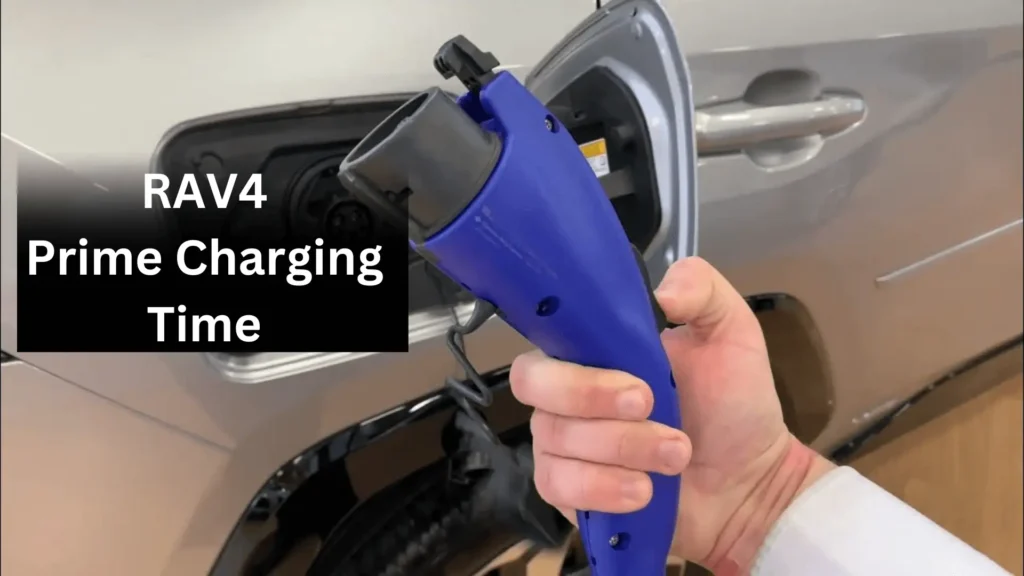The Toyota RAV4 Prime is a super cool SUV that runs on both electricity and gasoline. It’s one of the best in its class!
In this guide, we’re going to explore everything about charging your RAV4 Prime. We want to make sure you know exactly how to charge it.
We’ll cover all the bases, like how to charge it at home, making it super convenient when you’re on the road, and what things you need to think about when you’re charging it up.
So, buckle up, and let’s dive into making the most of your RAV4 Prime’s charging powers! Ready, set, go!
Toyota RAV4 Prime Charging Time
When you get a new Toyota RAV4 Prime, it comes with a charging cable included. This cable works for both the RAV4 Prime SE and XSE models. These are the only versions available for this model.
Both the SE and XSE versions come with a 3.3kW onboard traction battery charger. This charger is all you need to charge your RAV4 Prime.
However, if you opt for the XSE model, you have the option to upgrade with a Premium Package. This package boosts your onboard battery charger to 6.6kW. This means faster charging times for your vehicle.
How to Charge Toyota RAV4 Prime Battery?
Charging your Toyota RAV4 Prime can seem complicated at first, but don’t worry, we’ll break it down step by step.
Let’s start with charging at home. For most people, this is where you’ll do the bulk of your charging. There are two main options: using the standard charging cable that came with your car or installing a Level 2 charger.
The standard cable plugs into a regular 120V outlet and is fine for short daily drives. It takes about 12 hours to fully charge your RAV4 Prime this way. But if you’re driving more often, you might want to consider a Level 2 charger, which uses a 240V outlet and can charge your car in about 2.5 hours. While it may cost between $700 to $2,000 to install, it’s a convenient option for frequent drivers.
Now, when you’re out and about, public charging stations are your best friend. These are popping up everywhere, from parking lots to grocery stores. Use apps like PlugShare to find them. Charging at these stations is cheaper than gasoline, typically around $0.30 to $0.60 per kilowatt-hour.
Inside your RAV4 Prime, you can also schedule when you want to charge. This can help you take advantage of cheaper electricity rates during off-peak hours and ensure your car is fully charged when you need it. You can access these settings through the car’s display system.
With these charging options and settings, keeping your RAV4 Prime juiced up and ready to go is easy and convenient.
Important Specifications of Toyota RAV4 Prime Battery
Let’s delve into some crucial details about charging your Toyota RAV4 Prime. Charging might seem daunting at first, but trust me, it’s not as complicated as it sounds!
First off, let’s talk about the battery size. Your RAV4 Prime has a battery size of 18.1 kWh, but only about 14.5 kWh of that is usable. This is to protect the battery from damage by preventing over-draining.
Now, where do you plug in your charger? The charging port is located on the right side of the rear quarter panel, just above the tire. It’s hidden under a cover, similar to your gas cap. Push inward on the cover to open it up.
When you’re out and about and need to charge, you’ll want to know about the charging port type. Your RAV4 Prime uses the J1772 port type, which is standard for most electric vehicles besides Tesla. This means you can use almost any public charging station you come across.
Speaking of charging stations, there are two main types of chargers: Level 1 and Level 2. Level 1 chargers are slower but can be used with a standard 120V outlet at home, taking about 12 hours for a full charge. Level 2 chargers are faster, but you’ll need a 240V outlet installed at home. With a Level 2 charger, you can get a full charge in under three hours.
At home, using the standard Level 1 charger, it takes about 12 hours for a full charge. But at a public charging station or with a Level 2 charger, you’ll only need around 2.5 hours. This is because public stations typically use a higher-powered charger.
Lastly, keep in mind the length of your charging cable. The Level 1 charger that comes with your RAV4 Prime is about 24 feet long, which should be sufficient for most situations. Just remember not to use an extension cord or multi-outlet power strips, as they can cause overheating.
With these important specs in mind, you’ll be well-equipped to charge your RAV4 Prime hassle-free!
You should also check: BSM Toyota RAV4 Light (Explained)
Charging Cable Option
Let’s explore the charging cable options available for your Toyota RAV4 Prime. Depending on the outlets in your home, you’ll need either a Level 1 or Level 2 charger.
Level 1 Charger
For Level 1 charging, which uses a standard 120V outlet, your RAV4 Prime comes with a charger. This charger takes about 12 hours for a full charge, providing approximately 4 miles of driving range per hour. A great choice for a Level 1 charger is the Lectron NEMA 5-15 cable. It’s affordable, reliable, and has a length of 21 feet, making it easy to reach an outlet. Plus, it has handy indicator lights to track charging progress and alert you to any issues.
Level 2 Charger
If you have access to a 240V outlet, you can use a Level 2 charger, which charges much faster. This type of charger can fully charge your RAV4 Prime in less than 3 hours. To take advantage of Level 2 charging, consider the Morec NEMA 14-50 cable. It’s a 40-amp, 220-240 volt charger that meets compatibility standards for the RAV4 Prime.
Remember, if your home doesn’t already have a 240V outlet, you’ll need to hire an electrician to install one. But the faster charging times with a Level 2 charger can be well worth the investment, especially for those with longer daily commutes.
Charging Etiquette
Let’s talk about charging etiquette when it comes to electric vehicles (EVs). Charging your EV is different from filling up a gas tank because it takes longer, and charging stations can be limited.
As a new EV owner, it’s important to be considerate of others who may also need to charge.
- Respect the line: Sometimes, there might be a line of EV owners waiting to charge. Be patient and wait your turn.
- Follow time limits: Some charging stations may have time limits for parking while charging. Make sure to abide by these limits so others can have a chance to charge too.
- Don’t unplug others: If someone else’s car is already plugged in, don’t unplug it. Wait for them to finish charging before you plug in your vehicle.
- Charge only what you need: If people are waiting to charge, only charge as much as you need to reach your destination. This way, others can have a chance to use the charging station too.
- Park appropriately: Only park in EV spots when you need to charge. Don’t use these spots if you don’t need to charge, as it may prevent others who do need to charge from finding a spot.
By following these simple etiquette rules, you can ensure a positive charging experience for yourself and other EV owners.
Conclusion
In conclusion, charging your Toyota RAV4 Prime is a straightforward process with the provided charging cable. Whether you opt for the SE or XSE model, you have everything you need to keep your vehicle charged and ready to go. And if you choose the XSE with the Premium Package, you can enjoy even faster charging times. With these options, powering up your RAV4 Prime is convenient and hassle-free.

